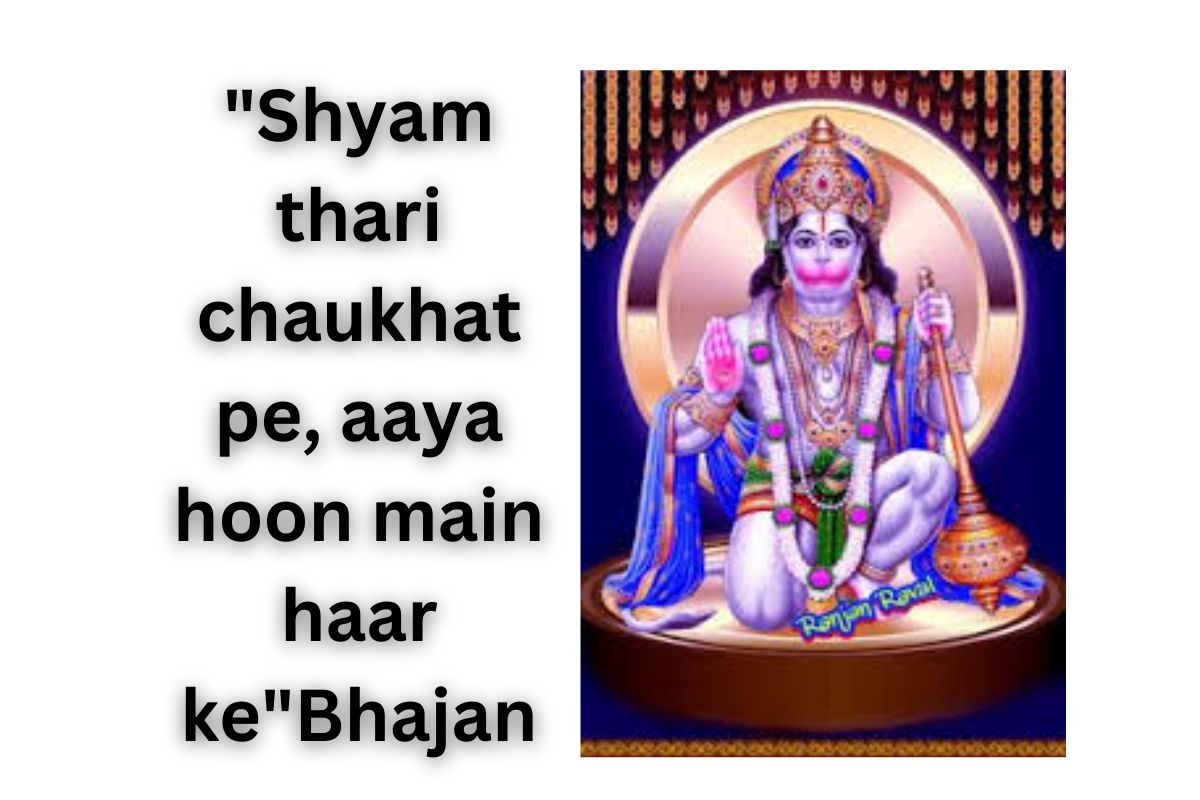श्याम थारी चौखट पे, आया हूँ मैं हार के भजन लिरिक्स “Shyam thari chaukhat pe, aaya hoon main haar ke”Bhajan lyrics
“Shyam thari chaukhat pe, aaya hoon main haar ke”The song is a devotional song expressing surrender and devotion to the divine. The lyrics describe the singer’s journey of coming to the doorstep of Shyam (a name for Lord Krishna) in a state of defeat or surrender. The singer seeks to become worthy in the eyes of the divine, acknowledging their shortcomings and expressing a desire to be accepted at the divine court. The lyrics reflect themes of humility, acceptance, and the seeking of spiritual guidance and support in times of difficulty. The singer acknowledges the challenges and trials of life but expresses faith in finding solace and strength in the presence of the divine. Overall, the song embodies a sentiment of seeking refuge and redemption in the divine presence, with a recognition of human fallibility and a yearning for spiritual growth and acceptance.
“Shyam thari chaukhat pe, aaya hoon main haar ke”यह गाना भगवान के प्रति अर्पण और भक्ति का एक भजन है। इसके बोल गायक की यात्रा का वर्णन करते हैं, जो भगवान श्याम (भगवान कृष्ण का एक नाम) के द्वार पर हार या आत्मसमर्पण की स्थिति में आता है। गायक ईश्वर की दृष्टि में पात्र होने की इच्छा व्यक्त करता है, अपनी अवगुणों को स्वीकार करता है और भगवानीय सभा में स्वीकृति की इच्छा व्यक्त करता है। गाने में विनम्रता, स्वीकृति और कठिनाइयों के समय में आध्यात्मिक मार्गदर्शन और सहारे की खोज के विषयों को दर्शाया गया है। गायक जीवन की चुनौतियों और परीक्षणों को स्वीकार करता है, लेकिन ईश्वर की उपस्थिति में शांति और शक्ति का आश्वासन देता है। समग्र रूप में, यह गाना भगवानीय उपस्थिति में आश्रय और पुनर्मिलन की भावना को उत्कृष्ट करता है, मानव अवगुणता की स्वीकृति और आध्यात्मिक विकास और स्वीकृति की एक आकांक्षा को प्रकट करता है।
| Feature | Detail |
| Song Title |
“Shyam thari chaukhat pe, aaya hoon main haar ke”
|
| Singers | Jogan ji |
| Music | Bhajan |
| Lyricist | Jogan ji |
| Actors | N/A |
| Release Date | N/A |
| Industry |
Bollywood
|
“Shyam thari chaukhat pe, aaya hoon main haar ke”Bhajan lyrics in English
“Shyam thari chaukhat pe,
Aaya hoon main haar ke,
Laayak bana lyo mhane,
Thaare darbaar ke,
Laayak bana lyo mhane,
Thaare darbaar ke.
Tarj – Chhoop gaya koi re door se pukaar ke.
Haaryoda ko saathi thaane,
Duniya bataave hai,
Dekh lyo athi ne kaani,
Laaj mhari jaave hai,
Kadsyu khadyo hoon baba,
Kadsyu khadyo hoon baba,
Haath pasaare ke,
Laayak bana lyo mhane,
Thaare darbaar ke.
Thak so gayo hoon baba,
Jag ke jhamele mein,
Jiyo ghabraave mharon,
Soch ke akale mein,
Kaalje laga lo ib the,
Kaalje laga lo ib the,
Avgun visaar ke,
Laayak bana lyo mhane,
Thaare darbaar ke.
Sukh mein to jag yo saaro,
Saath nibhaave hai,
Pan dukhde mein koi,
Needhe nahi aave hai,
Dagmag hai naiya bhaari,
Dagmag hai naiya mhari,
Bina patwaar ke,
Laayak bana lyo mhane,
Thaare darbaar ke.
Thaaro saath paa ke main bhi,
Jino sikh jaungaa,
The bhi thukra dyoga to,
Ji nahi paaunga,
Haar ke aayo hai ‘Binnu’,
Haar ke aayo hai ‘Binnu’,
Dwaare sarkaar ke,
Laayak bana lyo mhane,
Thaare darbaar ke.
Shyam thari chaukhat pe,
Aaya hoon main haar ke,
Laayak bana lyo mhane,
Thaare darbaar ke,
Laayak bana lyo mhane,
Thaare darbaar ke.”
“Shyam thari chaukhat pe, aaya hoon main haar ke”Bhajan lyrics in Hindi
“श्याम थारी चौखट पे,
आया हूँ मैं हार के,
लायक बना ल्यो म्हाने,
थारे दरबार के,
लायक बना ल्यो म्हाने,
थारे दरबार के।
तर्ज – छूप गया कोई रे दूर से पुकार के।
हार्योड़ा को साथी थाने,
दुनिया बतावे है,
देख ल्यो अठी ने कानी,
लाज म्हारी जावे है,
कद्स्यु खड़यो हूँ बाबा,
कद्स्यु खड़यो हूँ बाबा,
हाथ पसार के,
लायक बना ल्यो म्हाने,
थारे दरबार के।
थक सो गयो हूँ बाबा,
जग के झमेले में,
जियो घबरावे म्हारो,
सोच के अकेले में,
कालजे लगा लो इब थे,
कालजे लगा लो इब थे,
अवगुण विसार के,
लायक बना ल्यो म्हाने,
थारे दरबार के।
सुख में तो जग यो सारो,
साथ निभावे है,
पण दुखड़े में कोई,
नीडे नही आवे है,
डगमग है नैया भारी,
डगमग है नैया म्हारी,
बिना पतवार के,
लायक बना ल्यो म्हाने,
थारे दरबार के।
थारो साथ पा के मैं भी,
जीनो सिख जाऊंगा,
थे भी ठुकरा द्योगा तो,
जी नहीं पाऊंगा,
हार के आयो है ‘बिन्नू’,
हार के आयो है ‘बिन्नू’,
द्वारे सरकार के,
लायक बना ल्यो म्हाने,
थारे दरबार के।
श्याम थारी चौखट पे,
आया हूँ मैं हार के,
लायक बना ल्यो म्हाने,
थारे दरबार के,
लायक बना ल्यो म्हाने,
थारे दरबार के।”
“Shyam thari chaukhat pe, aaya hoon main haar ke”Bhajan lyrics in Urdu
“شیام تھاری چوکھٹ پہ،
آیا ہوں میں ہار کے،
لایق بنا لیو مھانے،
تھارے دربار کے،
لایق بنا لیو مھانے،
تھارے دربار کے۔
ترجمہ – چھپ گیا کوئی رے دور سے پکار کے۔
ہاریوڈا کو ساتھی تھانے،
دنیا بتاوے ہے،
دیکھ لیو اٹھی نے کانی،
لائج مھاری جاوے ہے،
کدسیو کھڑیو ہوں بابا،
کدسیو کھڑیو ہوں بابا،
ہاتھ پسار کے،
لایق بنا لیو مھانے،
تھارے دربار کے۔
تھک سو گیو ہوں بابا،
جگ کے جھمیلے میں،
جیو گھبراوے مھارو،
سوچ کے اکیلے میں،
کالجے لگا لو اب تھے،
کالجے لگا لو اب تھے،
اوگن وسار کے،
لایق بنا لیو مھانے،
تھارے دربار کے۔
سکھ میں تو جگ یو سارو،
ساتھ نبھاوے ہے،
پن دکھڑے میں کوئی،
نیڈے نہیں آوے ہے،
ڈگمگ ہے نیا بھاری،
ڈگمگ ہے نیا مھاری،
بنا پتوار کے،
لایق بنا لیو مھانے،
تھارے دربار کے۔
تھارو ساتھ پا کے میں بھی،
جینو سکھ جاؤنگا،
تھے بھی ٹھکرا دیوگا تو،
جی نہیں پاؤںگا،
ہار کے آیو ہے ‘بنو’,
ہار کے آیو ہے ‘بنو’,
دوارے سرکار کے،
لایق بنا لیو مھانے،
تھارے دربار کے۔
شیام تھاری چوکھٹ پہ،
آیا ہوں میں ہار کے،
لایق بنا لیو مھانے،
تھارے دربار کے،
لایق بنا لیو مھانے،
تھارے دربار کے۔”
FAQS
What is the meaning of “Shyam thari chaukhat pe, aaya hoon main haar ke”?
This line translates to “I have come to the doorstep of Shyam (Lord Krishna) in a state of defeat or surrender.”
Who composed “Shyam thari chaukhat pe, aaya hoon main haar ke”?
The composer of this bhajan is not always explicitly mentioned as it is a traditional devotional song. It is often sung in various renditions by different artists.
What is the significance of this bhajan?
The bhajan expresses the devotee’s humility, surrender, and devotion to Lord Krishna. It reflects the idea of seeking solace and strength in the divine presence, especially in times of difficulty or defeat.
Is there any specific occasion or festival when this bhajan is sung?
This bhajan can be sung on various occasions, including Krishna Janmashtami, Holi, Diwali, and other Krishna-related festivals. It is also sung in regular devotional gatherings or during personal prayers.
Are there any variations or additional verses to this bhajan?
Depending on the rendition or tradition, additional verses or variations may exist. However, the core message of surrender and devotion remains consistent across different versions.
Can anyone sing this bhajan, or is it meant for specific groups?
This bhajan can be sung by anyone regardless of age, gender, or background. It is meant for all devotees who seek to express their devotion and surrender to Lord Krishna.
Are there any specific instruments traditionally used when singing this bhajan?
Instruments commonly used when singing this bhajan include harmonium, tabla, dholak, and other traditional Indian musical instruments. However, the choice of instruments may vary based on the preference of the singer or the musical arrangement.




Post Comment